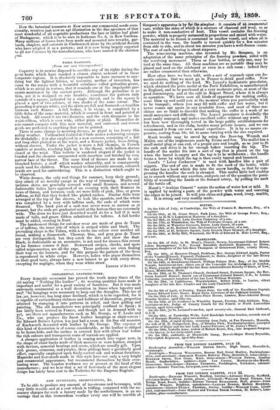ORNAMENTAL LEATHER-WORK.
Every domestic economist has proved the truth many times of the old saying " Nothing like leather" ; its wearing qualities have made it important and useful for a great variety of furniture. But it was made extremely ornamental as a wall decoration in times when tapestry and seek 'Ire hangings were necessary to keep out the draughts. This use of lea.,ter, however, has long since declined, which is to be regretted, for it is capable of extraordinary richness and boldness of decoration, properties attained by stamping it into patterns in relief, and then gilding and painting. The old manufacture was principally confined to Spain ; it has lately been revived in France, and though not in demand with us
et, are there not manufacturers such 'as Mr. George, or F. Leaks and Co., who can produce the finest leather hangings or chair-covers ? Sir Edward Bulwer Lytton his just had a room in his fine old mansion of Knebworth decorated with leather by Mr. George. The expense of this kind of decoration is of course considerable, as the leather is obliged to be horse-hide, and the surface is covered first with silver leaf before the rich colours and transparent coats of varnish are applied.
A cheaper application of leather is coming much into vogue now, in the shape of chair-backs made of thick morocco or roan leather, stamped with devices, armorial bearings and crests, which are usually gilt. Upon rich greens, crimsons, and purples, these gildings have a peculiarly good effect, especially employed upon finely-carved oak and walnut furniture. Hassocks and foot-stools made in this style have not only a very bright and ornamental appearance, but recommend themselves by their ever- lasting wear. The London workmen are at present at the head of this manufacture • and we hear that a set of foot-stools of the most elegant design has lately been sent to the Tuileries for the Empress Eugenic.


























 Previous page
Previous page